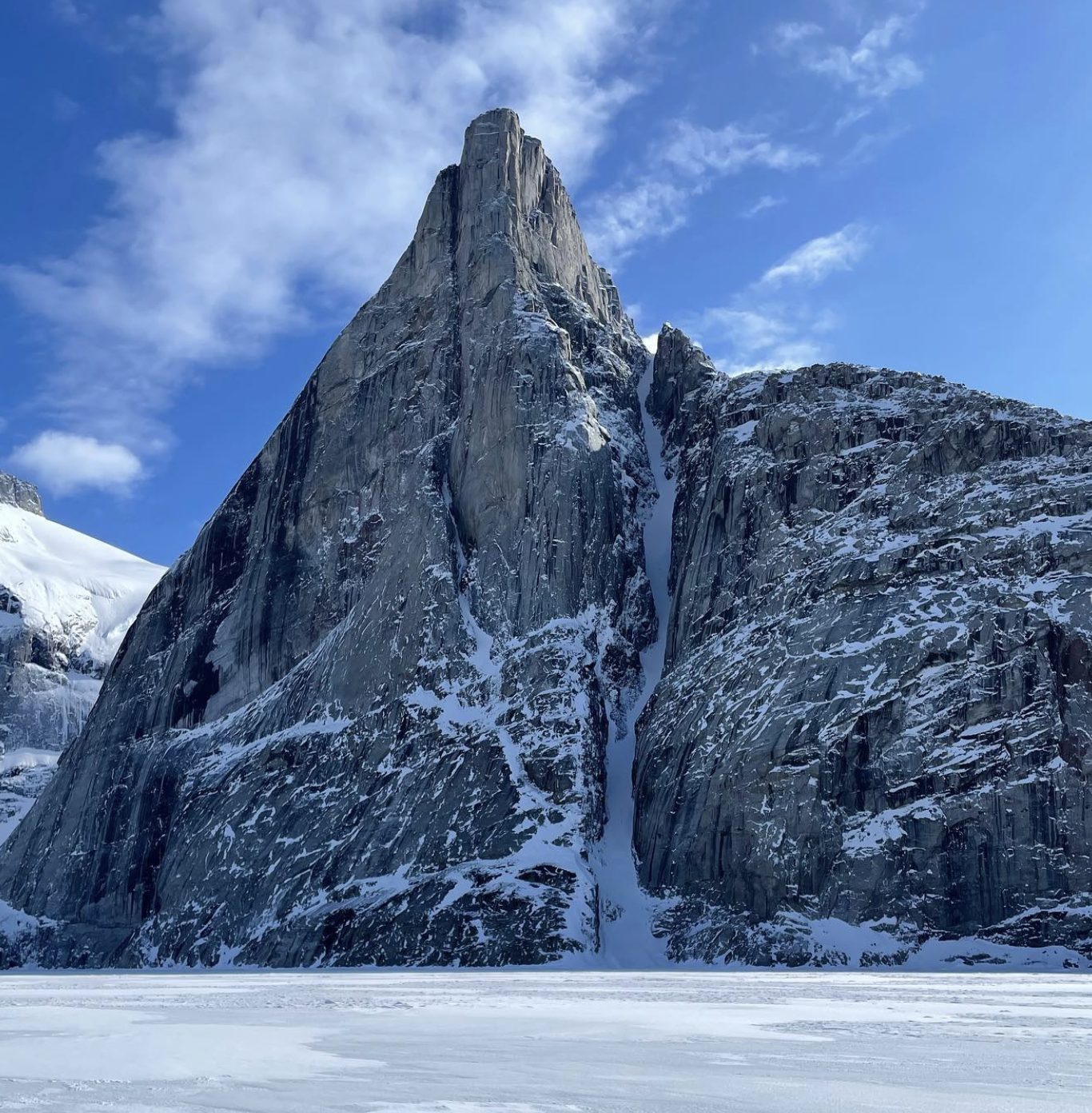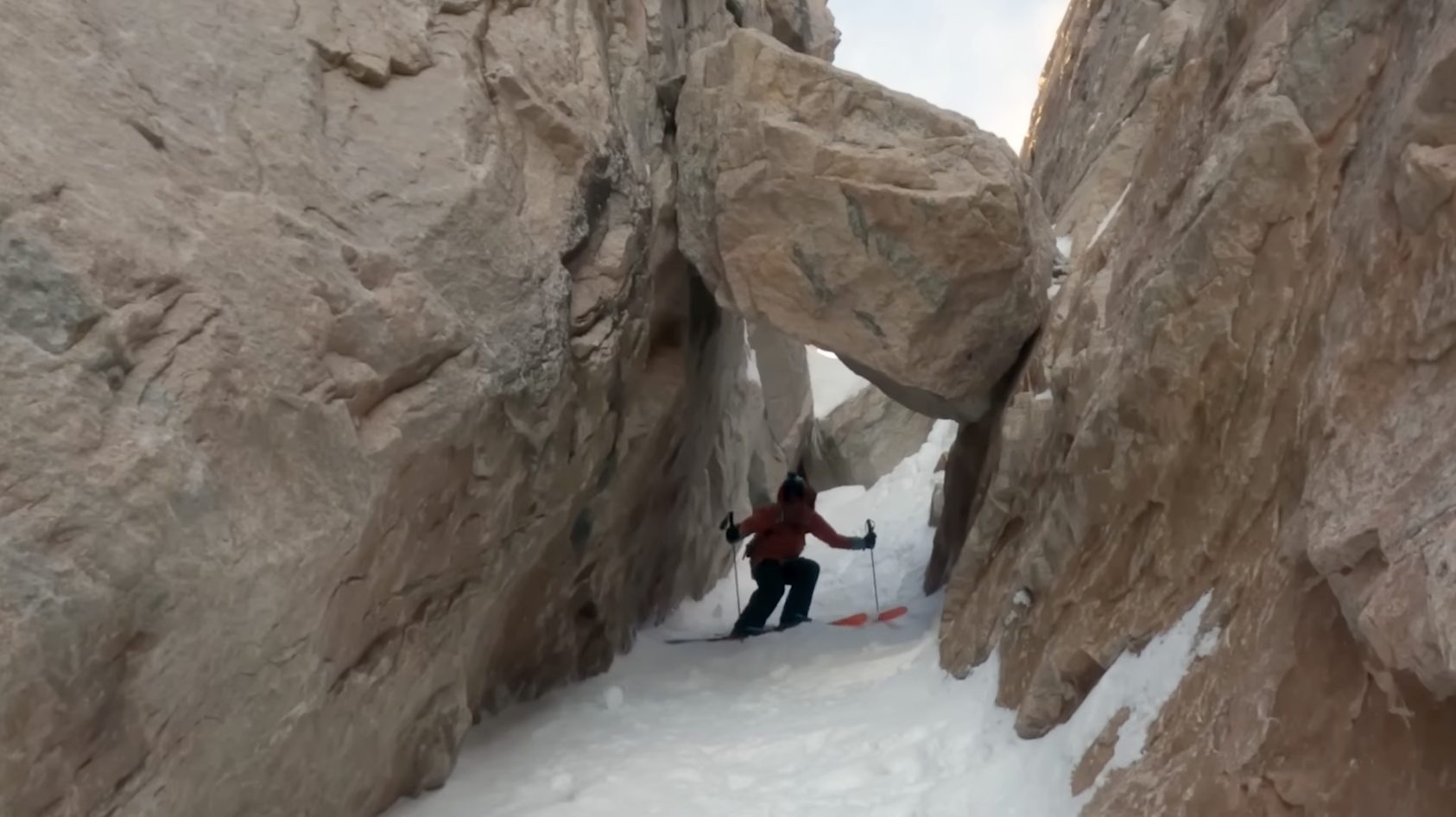
Cody Townsend’s “50 Project” is at the apex of its career with “The Polar Star,” a full-length feature film covering one of the project’s most coveted lines. In the film, Townsend, accompanied by cinematographer Bjarne Salen and IFMGA Mountain Guide Vivian Bruchez, embarks upon an adventure to Baffin Island in the far reaches of Canada’s Arctic Circle to ski the classic Polar Star Couloir, a 3,720-vertical-foot chute of dream-like quality in one of the most remote reaches of the Arctic. In the film, Townsend chronicles his journey with Salen and Bruchez, describing the process from start to finish with heartening moments and insightful learnings along the way. If “The 50 Project” had a showcase line, this would be it.
The film begins differently than most of the episodes of “The 50 Project.” Townsend, Salen, and Bruchez ski the line in the first few minutes of the film, with something like another 40 minutes left of the movie to watch afterward. Then the film does something interesting—something I haven’t seen in any episode of The 50 thus far. It backtracks to show in detail the logistics of how Townsend and his crew got to the line in the first place.
Getting to Baffin Island is a logistical nightmare. After a quick shot of Townsend, Salen, and Bruchez at the top of the line about to drop in on Day One of the adventure, the film doubles back to seven days before they started its climb. A digitally edited map of North America serves as a great visual aid to show the logistics of how to get to Baffin Island and helps the viewer understand how far away it really is from the rest of civilization. It is out there. Townsend and his crew flew from Lake Tahoe to Vancouver before arriving at Yellowknife in the Northwest Territories of Canada. There, they were forcefully delayed due to the airlines losing baggage that was crucial to their expedition. You can’t go skiing in the Arctic without skis. After several long, dull days of waiting in a cramped hotel room for their baggage to arrive in Yellowknife, they were finally able to board a charter flight to Baffin Island.
Arriving in Baffin, the sheer remoteness and vastness of the land upon which they have entered is highlighted well by Salen’s filming. Long, open shots of glaciers and fjords and a tiny, itty bitty settlement on the edge of the world all give a feel to the world they have landed in. It certainly isn’t any Vail or Deer Valley with ski concierge, coffee shops, chairlifts, or heated sidewalks. Upon arrival, Townsend and his crew hire some local guides who take them on a scenic sled ride to the base of the Polar Star Couloir. Salen’s filming of the breathtaking beauty of the region again makes it easy to see why anyone would love to ski here. There are world-class couloirs left and right.
One aspect I loved about the film was when, on the sled journey out to the Polar Star with the local guides, it really captured the culture of these people who live in such a brutally inhospitable place. On the way there, the guides are shown hunting and sharing their bounties with Townsend and his crew, demonstrating the subsistence lifestyle they live and a strong sense of community in a world that is exceptionally harsh and cold. It added a nice human element to the film that goes beyond the normal hike-up and ski-down style of each 50 Project episode.
Then, almost a week after they started their journey, they arrived at the base of the Polar Star Couloir, one of the most beautiful ski lines of the entire series. After setting up base camp, Townsend, Bruchez, and Salen begin the climb up the Polar Star. As they ascend they talk about the decisions they make regarding snow conditions and avalanche hazard, allowing the viewer to feel as though they are part of the decision-making process. They summit and ski the couloir on the first day of their 10-day expedition, descending it in excellent snow conditions. From there, with a whole expedition left to kill, they start looking at their surroundings for what they can ski next. And that’s when the film gets interesting.
Townsend, Salen, and Bruchez proceed to ski several more world-class lines in one of the most stunningly scenic backcountry ski areas on the globe. The lines they pick are really just “wow,” which is how I would describe them. They also seemed to have skied most of them in very good-quality snow, which you wouldn’t normally expect for a place like Baffin. The nature scenes captured by Salen are out of this world, along with his strong aerial drone shots of Townsend and Bruchez skiing. Salen did phenomenal work with the filming of the Polar Star, and his cinematography as a skiing filmmaker is at the height of its game. His filming, paired with strong POV GoPro footage from the team and Townsend’s casual yet descriptive storytelling make the film wildly entertaining and relatable to the average backcountry skier. You don’t have to be into going on massive ski expeditions to appreciate theirs.
Something that is perhaps easy to look over but worth mentioning is the accompanying soundtrack to this film. It is amazing when it comes to a ski movie. The ominous, suspenseful tones that build when Bruchez is mixed climbing; the playful, energetic pulsing when Townsend is slashing face shots—all of the soundtrack pairs with the climbing, skiing, and storytelling of The Polar Star in a captivating, engaging manner that goes beyond the usual ski or climbing flick.
The film also expands upon a more intimate note, focusing on one of the story’s key figures: Vivian Bruchez. Throughout the movie, Townsend tells Bruchez’s story and how he came to be the man and legendary steep skier he is today, from his family’s roots in the Chamonix Valley dating back to the 16th century to his incredible mental database of ski mountaineering knowledge as well as his humble, down-to-Earth demeanor. Like with the scene of the local hunters, Townsend’s storytelling in The Polar Star once again hammers upon the human element of this film, differentiating from all the ‘Powder Porn’ that is often prevalent throughout the media side of the ski industry. Through it, we learn something about the man Bruchez is, where he came from, why he does what he does (and how he does it so well), and the camaraderie shared by all three of them in a place as savage as Baffin Island. In the span of 44 minutes, Salen, Townsend, and Bruchez formed a brotherhood that will now likely last a lifetime, and it was wholesome to watch that unfold on the screen.
As far as ski movies go, this wasn’t really just a ski movie. It was more of a life movie that had some skiing in it. It showed the reality of what it was like to travel to an amazing ski destination in the far reaches of the planet such as Baffin, which is often frustrating and at times nearly impossible. It briefly touched on how local people interact with the environment and survive there. It showed what happens when you go on a beautiful expedition to an even more beautiful place with your friends, and the deep, unshakeable bonds that inherently form as a result. And, of course, it showed some damn good steep skiing that doesn’t serve to accomplish anything except get you frothing at the mouth for the winter ahead.
